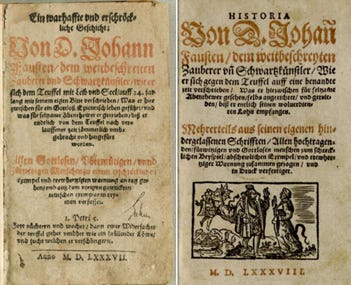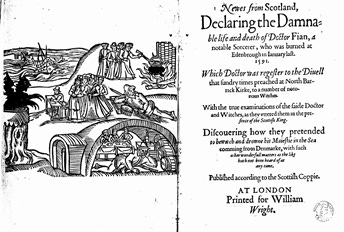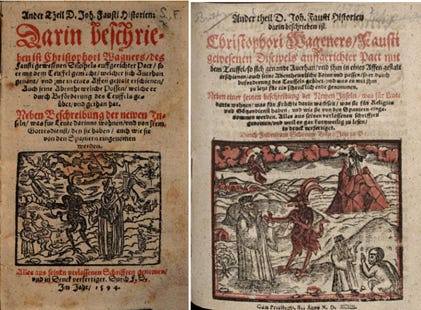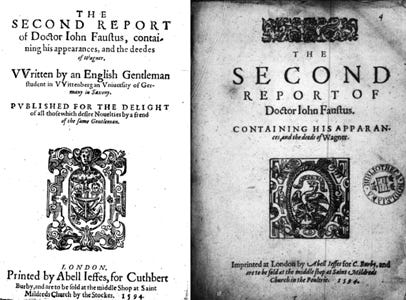‘ipsa scientia potestas est’ [‘knowledge itself is power’] [Francis Bacon, Meditationes Sacrae (1597)]
Who among us would willingly accept a Faustian bargain, to be granted unsurpassable worldly knowledge and otherwise unobtainable sexual pleasure – but only for an allotted span of time, and that in exchange for eternal damnation? This is the essence of Faust’s story in its numerous and varied accounts. Indeed, Faust has appeared in sundry guises. Thus the figure that emerges from late sixteenth- and seventeenth-century chapbooks, ballads and plays served not only to entertain but also to warn predominantly Protestant readers, listeners and spectators that the Devil was a subtle tempter. Likewise, many modern novelists, playwrights, poets, artists, composers and filmmakers have been inspired by Faustian themes, notably through dramatic explorations of how weak-minded individuals have been enticed to sell their integrity for short-term gain.
I. Writing, hearing and watching Faust
The oldest surviving version of Faust is a manuscript by an unknown author written sometime between 1572 and 1585. It is called Historia und Geschicht Doctor Johannis Fausti des Zauberers [The History and Story of Doctor Johannes Faustus the Magician] and is now held at the Herzog August Library in Wolfenbüttel.[1] Slightly later than the manuscript, the first printed narrative is an anonymous novelistic book entitled Historia von D. Johann Fausten dem weitbeschreyten Zauberer und Schwarzkünstler [History of Dr. Johann Faust, the notorious Magician and Necromancer]. This was published at Frankfurt-am-Main about September 1587 by Johann Spies (1540–1623). It was followed by a second, rhymed edition issued at Tübingen in January 1588.[2]
While the rhymed version was rendered into Danish in 1588,[3] the original prose was translated into English with embellishments and inaccuracies by ‘P.F.’ as The history of the damnable life, and deserved death of Doctor John Faustus. The earliest known copy of P.F.’s work was published at London in 1592.[4] A copyright dispute probably indicates that an edition of this translation may have been at least in gestation and perhaps even complete by about May that year.[5] Moreover, since the English title is not a literal rendering of the German, it may have drawn upon a pamphlet called News from Scotland, Declaring the Damnable life and death of Doctor Fian, a notable Sorcerer (1592).[6] This concerned the execution of John Cunningham [alias Sibbet Fian] (d.1591) who, along with some sixty others, had been implicated in a plot to drown James VI of Scotland by means of witchcraft.[7]
Then there is The Tragical History of D. Faustus by Christopher Marlowe (1564–1593). This may have been written as early as 1588 or, alternatively, as late as 1592 or even 1593, shortly before Marlowe’s murder at Deptford, Kent.[8] It is known to have been performed on a number of occasions from September 1594. The earliest edition of Marlowe’s play, however, was not published until 1604 (the ‘A-text’) and was then subsequently revised in 1616 (the ‘B-text’).[9]
After Marlowe’s killing his most popular plays were revived on the London stage, doubtless to capitalize upon his posthumous celebrity. Coinciding with these performances of Marlowe’s Faustus was the publication at London in 1594 of The Second Report of Doctor Iohn Faustus, containing his appearances, and the deeds of Wagner.[10] This was issued in two editions that year. The work’s purported author was an English gentleman who had studied at Wittenberg University in Saxony.
Another interesting example of Faust literature is an undated English ballad called The Judgement of God shewed upon one John Faustus Doctor in Divinity. The copy shown below has been dated to 1661–1663, shortly after the Restoration of the Stuart monarchy. Sung to the popular tune of ‘Fortune my foe’, a modern rendition can be heard here.
Also noteworthy are little-known English verse histories of Faust; a reissue of The Second Report of Doctor John Faustus (1680), which omitted the prefatory material of the 1594 editions; and a farce by William Mountford that was performed at various London theatres prior to its publication in 1697.
Turning to continental European literature, the most famous and perhaps greatest work on the subject is Johann Wolfgang von Goethe’s two-part tragedy Faust (1808, 1832). There are also twentieth-century adaptations, notably Mikhail Bulgakov’s The Master and Margarita (1928–40) and Thomas Mann’s Doktor Faustus (1947). Musical versions of the story include Richard Wagner’s Faust Overture (1839–40); Hector Berlioz’s La damnation de Faust (1846); Franz Liszt’s Faust Symphony (1857); and Charles Gounod’s five-act opera Faust (1859). Among the many cinematic versions highlights include F.W. Murnau’s Faust (1926); Doctor Faustus (1967) starring Richard Burton and Elizabeth Taylor; and Mephisto (1981), which won the Academy Award for Best Foreign-Language film.
II. Faust as literature
The wider setting in which the influential 1587 chapbook and its manuscript predecessor were conceived, disseminated and interpreted has been dubbed ‘The Faustian Century’. This was the age of the Northern Renaissance, the Magisterial and Radical Reformations, not to mention widespread witch hunts and the prevalence of occult beliefs. Thus my friend the late Andrew Weeks suggested that during the course of the sixteenth century the ‘finest vernacular literature of the Renaissance blossomed all across Europe’, everywhere, that is, ‘except in the sprawling German lands at the heart of Europe’. Despite what today sounds like ‘‘vulgar nationalism’ – to quote Weeks, the cornucopia represented by Niccolò Machiavelli (1469–1527), Torquato Tasso (1544–1595), Luis de Góngora (1561–1627), Miguel de Cervantes (1547–1616), François Rabelais (d.1553), Luís de Camões (c.1524–1579/80), Michel de Montaigne (1533–1592), Sir Philip Sidney (1554–1586), William Shakespeare (1564–1616) and Marlowe, to name just a few giants, must be set against what Weeks considered to be the literary deficiencies of the Historia von D. Johann Fausten (1587). For in his view this was a hastily and carelessly compiled narrative which ‘shunned humanistic literary refinements’. Moreover, it was clearly dependent upon the Bible and Protestant theology for its principal themes and sources. Consequently, in the assessment of another scholar, the result was no potential masterpiece. Rather it was ‘a flawed but successful literary formula of the late sixteenth century, a best seller that created a new archetypal plot and hero’.[11]
III. Faust as an historical figure
What then of Faust himself, whose name, meaning fist in German, most likely derives from the Latin noun for favourer or promoter? Of the historical person, or perhaps personages, we know frustratingly little. The fragments have been painstakingly assembled by scholars but it has proved challenging to connect them. Thus we know of one Georg Helmstetter of Helmstadt near Heidelberg. Apparently born about 1466 and dead before 1537, he was a graduate of Heidelberg University (BA 1484, MA 1487). Helmstetter cast a horoscope in 1490 and it has been suggested that he later settled upon an alias, indeed that he is to be identified with one Georgius Sabellicus. In August 1507 Sabellicus was denounced in a letter from the Benedictine Abbot Johannes Trithemius (1462–1516) to a friend who acted as court astrologer to the Elector Palatine. Here Trithemius inveighed against Sabellicus:
who has dared to call himself Prince of the Necromancers, is a vagrant, a windbag, and a wanderer; he deserves to be flogged, so he won’t dare continue to teach despicable things that contradict the holy church. What, after all, are the titles he has given himself, other than signs of a most foolish and absurd mind that proves he is a windbag and not a philosopher? Thus, he claims the following title, believing it suits him: Magister Georg Sabellicus, Faustus junior, wellspring of necromancers, astrologers, second of the magicians, chiromancer, aeromancer, pyromancer, second in hydromancy. Just look at the foolish audacity of this man![12]
Nonetheless, it is open to question as to whether Helmstetter was the same man as Sabellicus – especially in the absence of hard evidence linking the two figures. Then there is one John Faust (c.1480–c.1540) born in the little town of Knittlingen; a certain chiromancer called ‘Georgius Faustus, the Demigod of Heidelberg, a mere braggart and simpleton’ (1513); a ‘Doctor Faustus’ who cast a horoscope for the Bishop of Bamberg (1520); the soothsayer ‘Dr Jörg Faustus von Heidelberg’, who was expelled from Ingolstadt (1528); not to mention ‘Doctor Faustus, the great sodomite and necromancer’, who was denied safe conduct through Nuremberg (1532).
Since this was an age of aliases and pseudonyms we are most likely dealing with the conflation of several obscure historical figures. After all, an English trickster’s manual of 1634 was entitled Hocus Pocus junior, while Paracelsus – occasionally referred to as the ‘Luther of medicine’ – was the name adopted by Theophrastus of Hohenheim (c.1493–1541). Indeed, to quote a modern authority, by the end of the sixteenth century ‘Faust had become the name on which to hang any and all manner of suspect behaviour, whether by alleged magicians, freethinkers, apostates, free spirits, reprobates, or con artists’.
IV. Diabolic pacts
When it comes to particular aspects of the Faust legend, however, we are on surer ground as to their roots. Hence a diabolic pact occurs in certain saints’ lives. Examples include St. Basil (330–379), who saved a slave that had risked his soul by seeking Satan’s assistance to marry his master’s daughter. Then there was the legend of Theophilus, a sixth-century priest of Adana in Cilicia who, with the help of a Jew known for consorting with the Devil, entered into a written diabolic pact sealed by a ring. Theophilus was saved by a combination of repentance and the Virgin Mary’s intercession. Both his story and that of Basil were included within Jacobus de Voragine’s collection Legenda Aurea [The Golden Legend] (c.1260), which contained at least two more tales of Devil dealing.
The Golden Legend [Biblioteca Medicea Laurenziana, Florence]
The Faustbuch’s post-Reformation twist is that its protagonist does not avoid eternal damnation through repentance and instead suffers a horrible death: the just punishment of sinners – especially those doubting the reality of hell’s torments. This harsh lesson reinforces the anti-Catholic message embedded within the text. Hence one comedic episode sees Faust disguised as the Pope indulging his lust in the sultan’s harem in Constantinople. It proves a masterly performance by this well-endowed unwed man. Indeed, Faust later conjures the beautiful Helen of Troy for his concubine, with whom he has a son named Justus (on seeing what he apprehends to be a vision of Helen, Marlowe’s Faust exclaims: ‘Was this the face that launch’d a thousand ships). Also noteworthy is the twenty-four year duration of Faust’s bargain with Mephistopheles. Here each year doubtless corresponds to the number of hours in a day, perhaps serving as a narrative device to convey Faust’s knowledge of astrology.
V. The Reformation
Besides literary treatments of diabolic pacts, there are other contexts to consider. The most important is the Lutheran Reformation which began at Wittenberg, a university town that was likewise the birthplace of the ‘Faustian myth’. Then there is the Lutheran statement of faith promulgated in both German and Latin through the Augsburg Confession of 1530, not to mention internecine quarrels that, in the wake of Luther’s death in 1546, threatened to split apart the religious movement that he had been instrumental in founding. In particular, there were disputes between the followers of Matthias Flacius (1520–1575), now known as Gnesio-Lutherans, and the followers of Philip Melanchthon (1497–1560), known as Philippists.
Against this backdrop, the story of Faust can therefore be located within a climate of religious and indeed scientific reform. Among prominent figures worthy of discussion here are the Lutheran pastor Andreas Osiander (1498–1552), whose legend, in the opinion of a modern scholar, ‘tellingly resembles that of Dr Faustus’. Thus some thirty-five years after his death Osiander was defamed by a Catholic polemicist who noted that he had been called ‘a heretical Antichrist, a Jew, a black devil, a dragon, a nefarious man’ and a depraved ‘enemy of Christ’. Osiander had been active in Nuremberg, overseeing the publication of a collection of alchemical works (1541). He also supervised the publication of De Revolutionibus Orbium Coelestium [On the Revolutions of the Heavenly Spheres] (1543) by the Polish mathematician and astronomer Nicolaus Copernicus (1473–1543). Here Copernicus proposed a heliocentric rather than geocentric model of the heavens. That is to say, he believed that the Earth orbited the Sun rather than the Sun orbited the Earth.
Copernicus manuscript showing the order of the heavenly spheres
Then there is Luther himself, a former Augustinian monk doubtless familiar with Augustine of Hippo’s condemnation of Faustus the Manichaean, whose recorded table talk, according to a modern authority, ‘transformed the Faustus image into a wicked magician in league with the devil’. To take two examples, in the early 1530s Luther reportedly said:
The devil does not use magicians against me. If he had been able to hurt me, he would have succeeded long ago. He often had me by the head, but he had to release me.
Again, in a conversation of 1537:
Mention was made of scoffers and the magic art whereby Satan would blind men. They said much about Faust who called the devil his brother-in-law and had let it be known that “If I, Martin Luther, had but held out my hand to him, he would have ruined me, but I would not have feared him. I would have extended my hand in the name of the Lord God my protector, for I do believe much sorcery is committed against me.[13]
In a similar vein, Luther’s Wittenberg colleague Melanchthon was said by one of his students to have actually known a man named Faustus (this anecdote may have concerned Faust of Knittlingen).
VI. Faith and Reason
A further layer concerns the gulf between faith and reason, the emergence of classically informed scepticism, and the conflict between ecclesiastical authority and purported secret knowledge. Situated within a climate of anticlericalism and Lutheran hostility toward superstition (the Faustbuch’s depiction of the devil in a Franciscan habit even inspired a 1608 English engraving which visually combined these two tendencies by portraying Mephistopheles as a monk), the text must therefore be appreciated in light of several notable European works. Among them are Nicholas of Cusa’s De docta ignorantia [On Learned Ignorance] (1440); Sebastian Brant’s Das Narrenschiff [Ship of Fools] (1494); Desiderius Erasmus’s In Praise of Folly (1511); Heinrich Cornelius Agrippa’s De incertitudine et vanitate scientiarum [On the Uncertainty and Vanity of Sciences] (1526); and Michel de Montaigne’s Essais [Essays] (1570–92). Viewed this way, Faust becomes a lesson on the folly of human learning writ large, a warning to young students and others who arrogantly dare to know more than is permitted.
The History of the Damnable Life, and deserved death of Doctor John Faustus (1608)
VII. Magic
Another context still is the world of magical incantations and grimoires, diabolic pacts, witches, monstrous births, alchemical experimentation, astrological portents, dream interpretations, celestial signs and apocalyptic speculation. Here Faust’s significant forerunners can be identified as Johannes Trithemius, Heinrich Cornelius Agrippa and Paracelsus. Yet to adapt a well-worn phrase, the devil does not merely reside in the details. Rather, as God’s adversary and humanity’s enemy his appearance had eschatological import. And as Faust’s false teacher he has deservedly been the subject of scholarly treatments concerning his presence and absence in the early modern world, and sixteenth-century German literature in particular. The Devil, moreover, was a deceptive tempter, with those of a melancholic disposition believed to be most susceptible to his wiles.
Then there were the Devil’s instruments, including witches. For this was also the age of Heinrich Kramer’s and Jacob Sprenger’s notorious Malleus maleficarum [Hammer of Witches] (1486), of Johannes Wier’s De praestigiis daemonum et incantationibus [On the tricks of Demons and incantations] (Basel, 1563), and the widespread execution of suspected witches. Indeed, one prominent scholar has suggested that ‘the author of the Faust Book adapted, manipulated, and expanded a work that was primarily devoted to the persecution of witches’. Witches were accused of many dreadful sins which were typically imagined as inversions of idealised behaviour. While revealing much about contemporary fears it is noteworthy that one of their imagined diabolically motivated crimes was cannibalism. And there were indeed actual cannibals whom European adventurers had encountered in what is now Brazil (prompting a famous essay by Montaigne). It is also interesting to note that while the New World is absent from the Faustbuch (1587), it is present in the anonymous Wagnerbuch (1593) which developed the Faust story.
VIII. John Dee and Edward Kelley
I would like to finish this survey with a brief look at two English figures who have not yet been mentioned: the mathematician, astrologer and antiquarian John Dee (1527–1609) and the alchemist Edward Kelley (1555–1597/98). Dee, the title-character of an opera co-written by Damon Albarn, is deserving of a separate essay. Here I want to note that in May 1581 Dee gazed into a crystal ball and imagined he saw something. But except for a few occasions he needed the services of a scryer to communicate with spirits directly. That person was Kelley, who became Dee’s scryer in March 1582. Thereafter Dee recorded Kelley’s pretended visions and angelic conversations in several volumes, conceding that he could find no other way to attain ‘true wisdom’. In 1583 these ‘revelations’ took the form of a supposedly angelic language; characters represented as letters and numbers that filled grids of forty-nine rows by forty-nine columns. These tables were deemed to be ‘The sixth and holy book of mysteries’ or the Book of Enoch.
Portrait of John Dee (1527–1609) [Ashmolean Museum, Oxford]
Later that same year Dee, Kelley and their families left England bound for the continent. Kelley initially found favour with the Holy Roman Emperor Rudolf II (1552–1612) but was afterwards twice imprisoned. It is possible that he died from injuries sustained during an attempted escape. So reading the epilogue of Marlowe’s Faustus in light of both Marlowe’s and Kelley’s tragic deaths is perhaps a fitting way to end:
Cut is the branch that might have grown full straight,
And burned is Apollo’s laurel bough,
That sometime grew within this learned man.
Faustus is gone. Regard his hellish fall,
Whose fiendful fortune may exhort the wise,
Only to wonder at unlawful things,
Whose deepness doth entice such forward wits,
To practise more than heavenly power permits.
[Christopher Marlowe, The Tragical History of Doctor Faustus, epilogue]
[1] It was discovered by Gustav Milchsack and published by him in 1892. An English translation was subsequently issued in 1965.
[2] The author of the rhymed edition, Johannes Feinaug (1562–1627), together with the printer, Alexander Hock, so angered the authorities with this publication that the senate of the University of Tübingen ordered their imprisonment for several days.
[3] Interestingly, the London Stationers’ Company records the entry on 28 February 1589 of ‘A ballad of the life and death of Doctor Faustus the great Conjurer’.
[4] Since the title-page of this work declared that it was ‘newly imprinted, and in convenient places imperfect matter amended’, it has been asserted that ‘there must have been an earlier edition of which all trace is lost’. Furthermore, it has been suggested that this hypothetical first edition – which is no longer extant – was printed before 1590. There is evidence supporting this view, notably two brief references to ‘Faustus’. One is dated 5 November 1589 (although it was not printed until 1593), the other in a work published at Cambridge in 1590. In addition, there is the inventory of a deceased Oxford student’s library which can be dated between October and December 1589. He owned a copy of ‘Doctor Faustus’ that was likely written in English rather than Latin or German. But which version of ‘Doctor Faustus’ this student possessed is uncertain, let alone whether the work was printed or a scribal copy. It has also been argued that P.F. can be identified as one Paul Fairfax, an unlicensed medical practitioner. All the same, ‘P.F.’ may not have been the translator’s genuine initials.
[5] We know of this copyright dispute from an entry in the Stationers’ Company Court Book dated 18 December 1592. It can be read as implying that there was an earlier edition of P.F.’s History but that it had been issued by a different publisher.
[6] Alternatively, if there had been a pre-1590 edition of P.F.’s History then it could have been the source for the extended title of News from Scotland.
[7] Another work with a similar title concerned lycanthropy: A True Discourse. Declaring the damnable life and death of one Stubbe Peeter, a most wicked Sorcerer (no date). This was published at London with copyright entered in the Stationers’ Register on 22 June 1590.
[8] The dating of Marlowe’s Tragical History hinges upon when P.F.’s History was first published.
[9] However, copyright of a book called ‘The play of Doctor Faustus’ was entered in the Stationers’ Register on 7 January 1601.
[10] Copyright had been entered in the Stationers’ Register on 16 November 1593. The title has similarities with a German work issued the previous year, Ander theil D. Johann Fausti Historien / darin beschriben ist. Christoph Wagners Fausti gewesenen Discipels auffgerichter Pact mit dem Teuffel so sich genändt Auerhan (1593). Even so, it has long been known that the Second Report bears little resemblance to its German predecessor.
[11] By contrast, J.M. van der Laan thought that the Faustbuch ‘deserves a place of distinction as one of the very first great prose novels of the modern era in Europe’.
[12] I have used the English translation in a PhD from 2023 by Dustin Wayne Lovett.
[13] Again, I have used the English translation by Dustin Wayne Lovett.

















Great work, as always. I hope you will do a post on John Dee
Amazing article, Ariel, as always. You have reconstructed Dr. Faustus's literary history in a concise but thorough way. Now, all of us know much better about Faustus thanks to you.